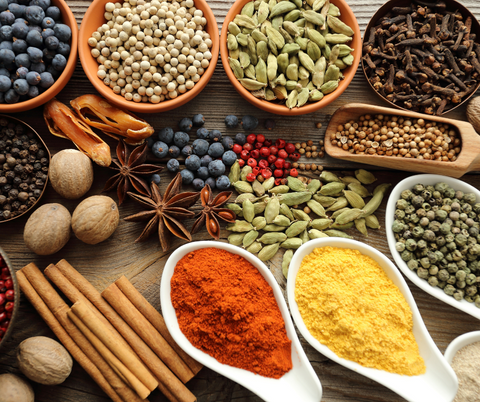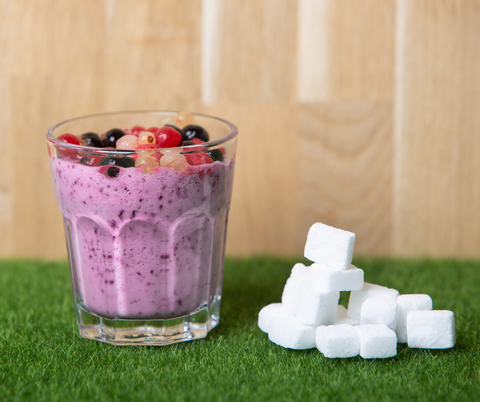Did you know that certain foods and spices can help warm you up?
When the temperatures outside start to dip our bodies need to generate heat to keep us warm. Thermogenic spices meaning "heat creating" such as cayenne, cinnamon, and ginger are said to have heat generating and fat burning qualities. The term thermogenesis is a process in which your body utilizes the food (calories) you’ve just eaten, then converts the calories into fuel and heat. So theoretically if you consume foods with warming spices your core temperature rises and your metabolism speeds up.
Western science has been doing numerous studies and is starting to providing more data to support these ideas with promising results supporting health-promoting claims of warming spices.These heat creating foods and spices however, have been used in Eastern culture for centuries for medicinal and culinary purposes. Ayurveda originating in India over 5,000 years ago is often called the mother of all healing. Overall its emphasis is on maintaining balanced life with a healthy diet, thinking and herbs focusing on 3 main energies Vata, Pitta and Kapha. In Chinese medicine these warming foods are referred to as yang foods and activate bodily functions to focus on health and the flow of personal energy Qi.
Many of spices have compounds that help raise core body temperature, aid digestion, help blood circulation, which will help us stay toasty during cold temperatures. An added bonus is that by speeding up our metabolism we in turn burn more calories and burn more fat.
Let's dive in and and talk about the spices most widely known and used.
Black Pepper
Peppercorns are one of the most commonly used spices that is used worldwide. Did you know that evidence of people use pepper has dated back 2000 BC in India? They grow as berries on a vine are dried whole. They are then used either whole or ground but if you freshly grind you will get most flavour and heat. Keep a pepper mill on hand instead of freshly ground pepper to get more benefits. The active ingredient piperine helps promote flushed skin and perspiration. It has thermogenic affects by increasing blood circulation, creating warmth in the body. It also can aid with digestion issues, such as gas, indigestion, and constipation by increasing stomach acid secretion. Mostly used in savoury dishes, pepper pairs nicely with vanilla and can be added to yogurt, cakes and sauces. Black pepper also enhances benefits of turmeric so add a sprinkle to ramp up the benefits.
Cardamom
Cardamom has been used in different medicinal ways for centuries and is one of the world's most ancient spices. It grows on a plant and each fruit contains up to eighteen seeds. They are dried and used whole or ground mostly used in curries and desserts due to is gingery pine flavour. Considered a warming spice as it stimulates blood circulation and also aids in digestion. Thanks to its thermogenic effects it may boost your metabolism and burn more fat. You can add cardamom to curries, fish and chicken dishes, desserts and to coffee/tea before steering. Just remember that a small amount will go a long way.
Cinnamon
This woody spice comes from the inner bark of evergreen trees that are native to SriLanka. Once peeled away from the tree as it dries it begins to curl up into tubes. There are many varieties of cinnamon but many consider Ceylon the "true cinnamon". The Chinese variety cassia is more popular in North America however the Ceylon is more refined and has a more subtle flavour. In history is was highly treasures and was considered more precious than gold. In terms of a heating spice, researchers say it can actually increase the amount of carbon dioxide produced in the stomach, restricting blood circulation by constricting your blood vessels. This helps retain body heat and makes you feel warmer by raising body temperature. Cinnamon has a vast amount of properties but use it it very small amounts. Add cinnamon to tea, coffee or hot water and lemon. Add cinnamon to oatmeal, stews, nachos, meats, and sauces. Using a small amount will bring out flavours and you will gain the benefits.
Cloves
Cloves have been consumed in Asia for more that 2,000 years. The clove is the unopened flower bud of the clove tree. The buds are pink and turn brown after they are hand picked and dried. The oily compound is the essential part to their medicinal, and nutritional benefits. Cloves contain a component called eugenol which has shown many benefits, preventing issues with digestive tract, treatment of joint inflammation and widely used in dentistry. Their thermogenic effects may be to raise core body temperatures and promote blood circulation. Cloves have a very intense flavour so a little will go a long way. Can be used with apples or apple code, use a pinch in coffee to boost flavour, can also add whole cloves to vegetable or bone broths.
Ginger
Ginger is considered an herb that grows underground and can be dried into a powder, used freshly grated, or even pickled. Native to Southern Asia, India and China it has long been valued for its aromatic, culinary, medicinal properties. It has been used in so many ways but the most common is to alleviate symptoms of gastrointestinal distress. Ginger is also widely used as an anti-inflammatory used to to relive arthritis pain. Ginger is a vasodilator,meaning it increases the diameter of small arteries and enhances circulation of the blood. Increased blood flow and circulation typically lead to a small increase in body temperature. While it minimally will increase core body temperature, usually combined with other warming spices you will definitely feel an overall effect.
Cayenne
Cayenne or red pepper is the fruit of a shrubby tropical plant grown as berry. The use of cayenne can be traced back to 7,000 years in Central and South America. The intense heat produced by cayenne pepper comes from its high concentration of capsaicin. It is this potent component that is responsible for the ability to increase your basal metabolic rate (BMR) and stimulate the burning of fat for energy. This will help with raising core temperatures and feeling a sense of warmth. Adding just a dash to hot cocoa, stews, soups can give you just the heat you need.
Turmeric
Did you know that turmeric is a member of the ginger family? The fresh root is usually cured (boiled, cleaned, and sun-dried, polishes, and ground into a powder. It has only become increasingly used in the Western culture but has been cultivated and harvested since 3000 BC in Indonesia and southern India. Compounds that are present in turmeric are volatile oils, potassium, omega-3 fatty acids, linolenic acids, proteins, carbohydrates, fibres, which provide this spice with anti-inflammatory, antioxidant, analgesic, anti-microbial and thermogenic properties. Be careful when using as its deep orange/yellow colour will stain easily. Make curry powders, add to rice and potato dishes, salads, stews and broths to warm up and gain the benefits.
Using these warming spices on their own or in combination will keep your metabolism going and increase your overall core body temperature. It doesn't mean you won't need to bundle up but when you get that chill just add one or more of these spices to your meal or beverages. My favourite is using turmeric in lattes and salad dressings and stews. Every morning I warm up and kick my metabolism into high gear with a warm cup of water that has been steeping with ginger, cinnamon, turmeric and lemon. I will admit that I can feel the warmth throughout out my body. Give it a try or try something of your own and feel like you are being wrapped in a blanket.



